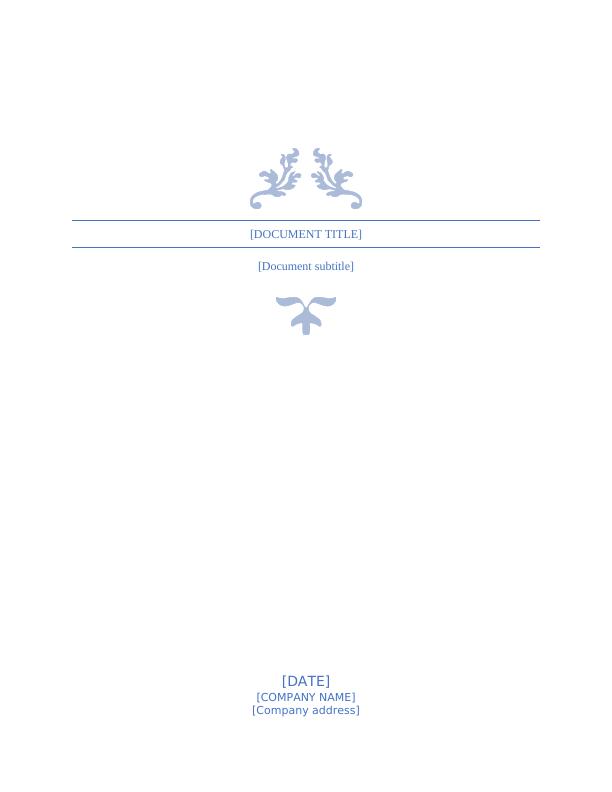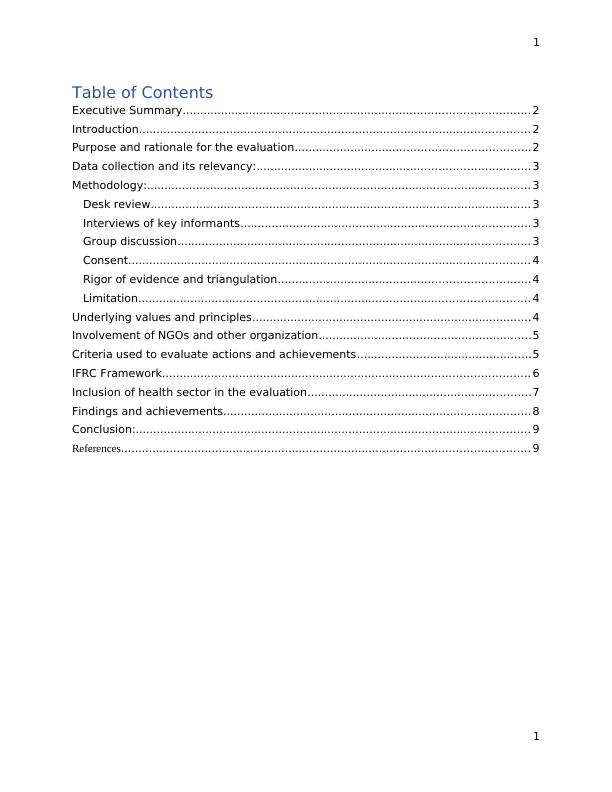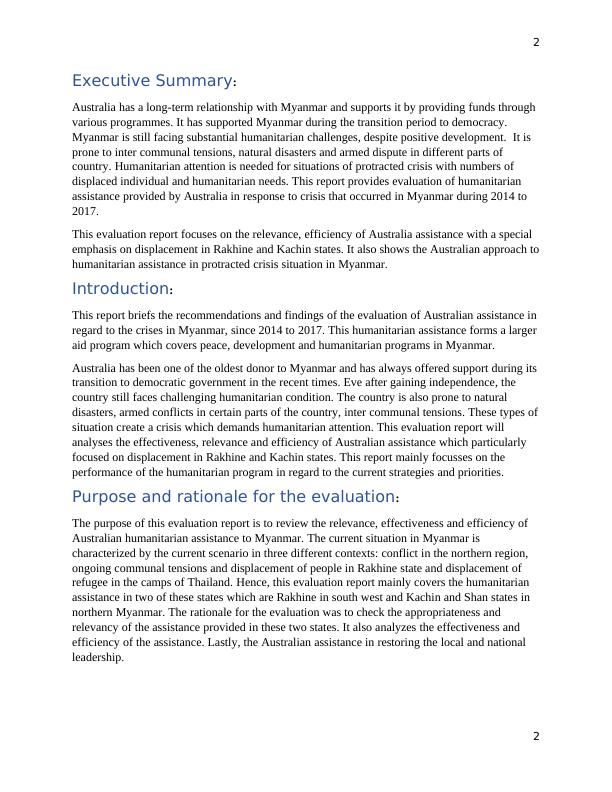Evaluation of a new evidence-based approach to informative research
Added on 2021-05-31
12 Pages4064 Words364 Views
[DOCUMENT TITLE]
[Document subtitle]
[DATE]
[COMPANY NAME]
[Company address]
[Document subtitle]
[DATE]
[COMPANY NAME]
[Company address]

1
Table of Contents
Executive Summary................................................................................................... 2
Introduction................................................................................................................ 2
Purpose and rationale for the evaluation...................................................................2
Data collection and its relevancy:.............................................................................. 3
Methodology:.............................................................................................................. 3
Desk review............................................................................................................. 3
Interviews of key informants................................................................................... 3
Group discussion..................................................................................................... 3
Consent................................................................................................................... 4
Rigor of evidence and triangulation........................................................................4
Limitation................................................................................................................ 4
Underlying values and principles................................................................................4
Involvement of NGOs and other organization.............................................................5
Criteria used to evaluate actions and achievements..................................................5
IFRC Framework......................................................................................................... 6
Inclusion of health sector in the evaluation................................................................7
Findings and achievements........................................................................................ 8
Conclusion:................................................................................................................. 9
References..................................................................................................................... 9
1
Table of Contents
Executive Summary................................................................................................... 2
Introduction................................................................................................................ 2
Purpose and rationale for the evaluation...................................................................2
Data collection and its relevancy:.............................................................................. 3
Methodology:.............................................................................................................. 3
Desk review............................................................................................................. 3
Interviews of key informants................................................................................... 3
Group discussion..................................................................................................... 3
Consent................................................................................................................... 4
Rigor of evidence and triangulation........................................................................4
Limitation................................................................................................................ 4
Underlying values and principles................................................................................4
Involvement of NGOs and other organization.............................................................5
Criteria used to evaluate actions and achievements..................................................5
IFRC Framework......................................................................................................... 6
Inclusion of health sector in the evaluation................................................................7
Findings and achievements........................................................................................ 8
Conclusion:................................................................................................................. 9
References..................................................................................................................... 9
1

2
Executive Summary:
Australia has a long-term relationship with Myanmar and supports it by providing funds through
various programmes. It has supported Myanmar during the transition period to democracy.
Myanmar is still facing substantial humanitarian challenges, despite positive development. It is
prone to inter communal tensions, natural disasters and armed dispute in different parts of
country. Humanitarian attention is needed for situations of protracted crisis with numbers of
displaced individual and humanitarian needs. This report provides evaluation of humanitarian
assistance provided by Australia in response to crisis that occurred in Myanmar during 2014 to
2017.
This evaluation report focuses on the relevance, efficiency of Australia assistance with a special
emphasis on displacement in Rakhine and Kachin states. It also shows the Australian approach to
humanitarian assistance in protracted crisis situation in Myanmar.
Introduction:
This report briefs the recommendations and findings of the evaluation of Australian assistance in
regard to the crises in Myanmar, since 2014 to 2017. This humanitarian assistance forms a larger
aid program which covers peace, development and humanitarian programs in Myanmar.
Australia has been one of the oldest donor to Myanmar and has always offered support during its
transition to democratic government in the recent times. Eve after gaining independence, the
country still faces challenging humanitarian condition. The country is also prone to natural
disasters, armed conflicts in certain parts of the country, inter communal tensions. These types of
situation create a crisis which demands humanitarian attention. This evaluation report will
analyses the effectiveness, relevance and efficiency of Australian assistance which particularly
focused on displacement in Rakhine and Kachin states. This report mainly focusses on the
performance of the humanitarian program in regard to the current strategies and priorities.
Purpose and rationale for the evaluation:
The purpose of this evaluation report is to review the relevance, effectiveness and efficiency of
Australian humanitarian assistance to Myanmar. The current situation in Myanmar is
characterized by the current scenario in three different contexts: conflict in the northern region,
ongoing communal tensions and displacement of people in Rakhine state and displacement of
refugee in the camps of Thailand. Hence, this evaluation report mainly covers the humanitarian
assistance in two of these states which are Rakhine in south west and Kachin and Shan states in
northern Myanmar. The rationale for the evaluation was to check the appropriateness and
relevancy of the assistance provided in these two states. It also analyzes the effectiveness and
efficiency of the assistance. Lastly, the Australian assistance in restoring the local and national
leadership.
2
Executive Summary:
Australia has a long-term relationship with Myanmar and supports it by providing funds through
various programmes. It has supported Myanmar during the transition period to democracy.
Myanmar is still facing substantial humanitarian challenges, despite positive development. It is
prone to inter communal tensions, natural disasters and armed dispute in different parts of
country. Humanitarian attention is needed for situations of protracted crisis with numbers of
displaced individual and humanitarian needs. This report provides evaluation of humanitarian
assistance provided by Australia in response to crisis that occurred in Myanmar during 2014 to
2017.
This evaluation report focuses on the relevance, efficiency of Australia assistance with a special
emphasis on displacement in Rakhine and Kachin states. It also shows the Australian approach to
humanitarian assistance in protracted crisis situation in Myanmar.
Introduction:
This report briefs the recommendations and findings of the evaluation of Australian assistance in
regard to the crises in Myanmar, since 2014 to 2017. This humanitarian assistance forms a larger
aid program which covers peace, development and humanitarian programs in Myanmar.
Australia has been one of the oldest donor to Myanmar and has always offered support during its
transition to democratic government in the recent times. Eve after gaining independence, the
country still faces challenging humanitarian condition. The country is also prone to natural
disasters, armed conflicts in certain parts of the country, inter communal tensions. These types of
situation create a crisis which demands humanitarian attention. This evaluation report will
analyses the effectiveness, relevance and efficiency of Australian assistance which particularly
focused on displacement in Rakhine and Kachin states. This report mainly focusses on the
performance of the humanitarian program in regard to the current strategies and priorities.
Purpose and rationale for the evaluation:
The purpose of this evaluation report is to review the relevance, effectiveness and efficiency of
Australian humanitarian assistance to Myanmar. The current situation in Myanmar is
characterized by the current scenario in three different contexts: conflict in the northern region,
ongoing communal tensions and displacement of people in Rakhine state and displacement of
refugee in the camps of Thailand. Hence, this evaluation report mainly covers the humanitarian
assistance in two of these states which are Rakhine in south west and Kachin and Shan states in
northern Myanmar. The rationale for the evaluation was to check the appropriateness and
relevancy of the assistance provided in these two states. It also analyzes the effectiveness and
efficiency of the assistance. Lastly, the Australian assistance in restoring the local and national
leadership.
2

3
Data collection and its relevancy:
The Australian humanitarian act was conducted on the basis of various data and information it
had on the two states of Myanmar i.e. Rakhine and Kachin. The DFAT’s collected data on
number of displaced people in these two states, number of children who were not accompanied
by the parents or family members, the data on domestic violence, data on generic based violence
and reproductive and health related problems in women, girls etc. These data were the basis in
which the aids were distributed in different sectors to help the people’s in need.
The Shan and Kachin states had more than 120,000 people who were in the need of assistance
which also included 98,000 displaced people because of the conflict (Annan, 2017). The 50%
of these displaced people live outside the reach of government where the access to assistance
was least. Around 77 to 78% of camp resident in Kachina state were women and children.
Similarly, over 400,000 people in Rakhine needed assistance. The communal violence of 2012
displaced 145,000 people and among these 120,000 remain displaced till the mid of 2017. 79%
of people in IDP camps were women and children. The security operations of 2016 and 2017
further displaced 20,000 people and approximately 70,000 displaced to Bangladesh. These data
helped in planning and successful implementation of humanitarian assistance.
Methodology: This section used both qualitative and quantitative approach to triangulate
key findings. The qualitative approach included stakeholder interviews, group discussions and
desk review. While the quantitative data set included OCHA financial tracking system and
Australian humanitarian funding allocations. There were also short sight visits in the state of
Rakhine and Kachin to capture the actual experience of the people affected in this region (About
OCHA Myanmar, n.d.).
Desk review
In this review, 113 documents were analyzed which included strategic documents, UN and
implementing partner strategy documents, proposals and papers etc.
Interviews of key informants
The semi structured interview included 27 women and 19 men. While the key informants
included 21 implementing partner representative, 13 DFAT staff, 2 donor and 3 other
stakeholders.
Group discussion
This was conducted to capture the view of the affected population on the service or assistance
provided and the way in which the groups (sex segregated) participated in and influenced the
partner programs. Out of 107 representatives involved in group discussion, 6 communities which
represented internal displaced camp and community population in Rakhine and Kachin were the
consultant. The other consultation included 7 representatives from disabled people organization
in Yangon. The main objective of this discussion was to understand the barrier and priorities for
persons who were living with disabilities in condition of protracted crisis.
3
Data collection and its relevancy:
The Australian humanitarian act was conducted on the basis of various data and information it
had on the two states of Myanmar i.e. Rakhine and Kachin. The DFAT’s collected data on
number of displaced people in these two states, number of children who were not accompanied
by the parents or family members, the data on domestic violence, data on generic based violence
and reproductive and health related problems in women, girls etc. These data were the basis in
which the aids were distributed in different sectors to help the people’s in need.
The Shan and Kachin states had more than 120,000 people who were in the need of assistance
which also included 98,000 displaced people because of the conflict (Annan, 2017). The 50%
of these displaced people live outside the reach of government where the access to assistance
was least. Around 77 to 78% of camp resident in Kachina state were women and children.
Similarly, over 400,000 people in Rakhine needed assistance. The communal violence of 2012
displaced 145,000 people and among these 120,000 remain displaced till the mid of 2017. 79%
of people in IDP camps were women and children. The security operations of 2016 and 2017
further displaced 20,000 people and approximately 70,000 displaced to Bangladesh. These data
helped in planning and successful implementation of humanitarian assistance.
Methodology: This section used both qualitative and quantitative approach to triangulate
key findings. The qualitative approach included stakeholder interviews, group discussions and
desk review. While the quantitative data set included OCHA financial tracking system and
Australian humanitarian funding allocations. There were also short sight visits in the state of
Rakhine and Kachin to capture the actual experience of the people affected in this region (About
OCHA Myanmar, n.d.).
Desk review
In this review, 113 documents were analyzed which included strategic documents, UN and
implementing partner strategy documents, proposals and papers etc.
Interviews of key informants
The semi structured interview included 27 women and 19 men. While the key informants
included 21 implementing partner representative, 13 DFAT staff, 2 donor and 3 other
stakeholders.
Group discussion
This was conducted to capture the view of the affected population on the service or assistance
provided and the way in which the groups (sex segregated) participated in and influenced the
partner programs. Out of 107 representatives involved in group discussion, 6 communities which
represented internal displaced camp and community population in Rakhine and Kachin were the
consultant. The other consultation included 7 representatives from disabled people organization
in Yangon. The main objective of this discussion was to understand the barrier and priorities for
persons who were living with disabilities in condition of protracted crisis.
3

End of preview
Want to access all the pages? Upload your documents or become a member.
Related Documents
Report on the IFRC Framework 5 International Federation of Red Cross and Red Crescent Societieslg...
|11
|3669
|93
Evaluation of Humanitarian Response in Myanmarlg...
|18
|4476
|76
A Critical Analysis of a Humanitarian Interventionlg...
|16
|4256
|77
Critical Analysis of an Evaluation Essaylg...
|14
|4015
|273
